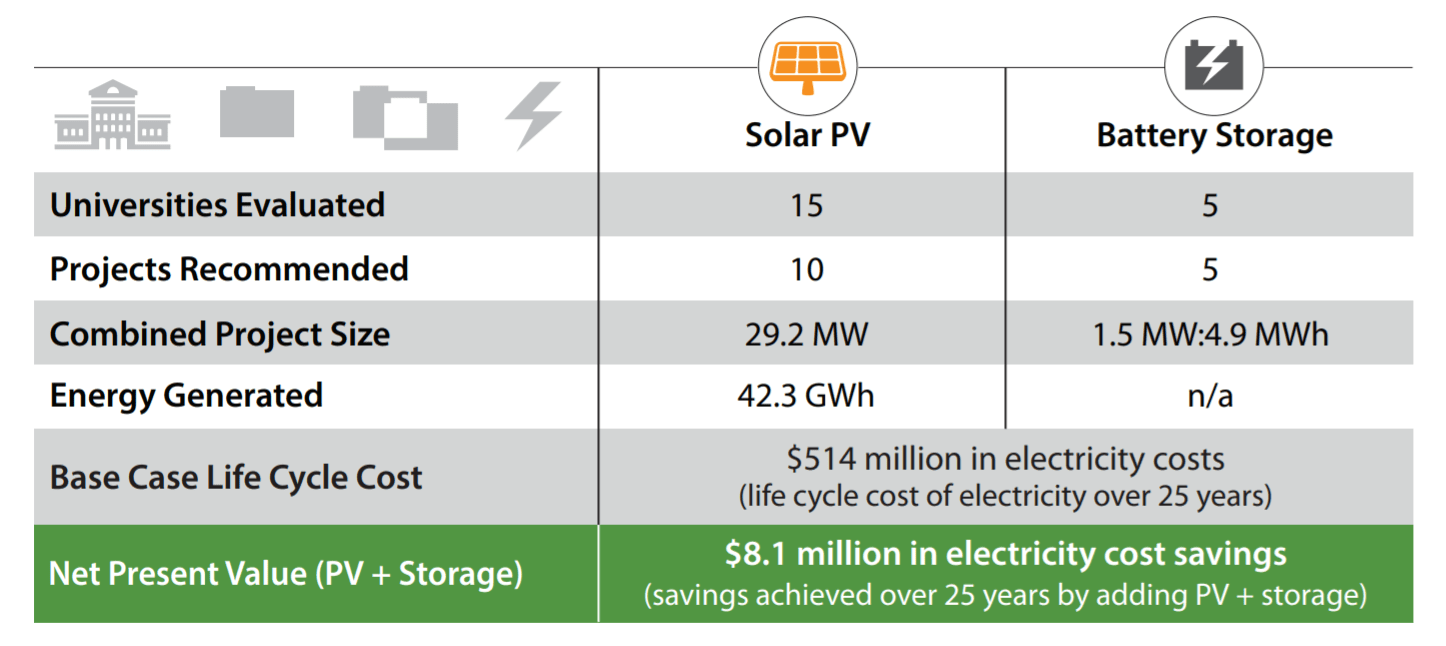A series of screenings carried out by the National Renewable Energy Laboratory (NREL) at universities nationwide have illustrated the potential benefits of solar PV and energy storage systems for educational institutions. The screenings, which took place in 2016 and 2017, focused on 15 carefully-selected universities, chosen based on criteria such as:
- Campus Solar & Sustainability Goals
- Plans for Future Solar Projects & Solar Deployment
- Capacity (MW)
- Regional Diversity
- Energy Costs
- Availability of Campus Energy Data for the Analysis
- Utility Rates
- RE Resources
- Technology Cost & Performance
- State, Utility, & Federal Incentives
- Economic Parameters (Discount Rate, Inflation Rates)
- Cost-Effectiveness of PV & Storage
- Recommended System Size
- Estimated Capital Cost to Implement the Technology
- Estimated Life Cycle Cost Savings
- Beloit College
- Beloit, WI; 8.9 GWh/year.
- Fairleigh Dickinson University
- Hackensack, NJ; 24 GWh/year.
- Georgia Tech
- Atlanta, GA; 316 GWh/year.
- Lake Superior College
- Duluth, MN; 5 GWh/year.
- Lane Community College
- Eugene, OR; 12 GWh/year.
- Luther College
- Decorah, IA; 14 GWh/year.
- Northern Arizona University
- Flagstaff, AZ; 64 GWh/year.
- Milwaukee Area Technical College
- Milwaukee, WI; 29 GWh/year.
- South Central College
- North Mankato, MN; 2.25 GWh/year.
- Thomas College
- Waterville, ME; 2.9 GWh/year.
- Tuskegee University
- Tuskegee, AL; 26 GWh/year.
- University of California—Riverside
- Riverside, CA; 113 GWh/year.
- University of Colorado–Colorado Springs
- Colorado Springs, CO; 23 GWh/year.
- University of Minnesota—Duluth
- Duluth, MN; 40 GWh/year.
- Washington and Lee University
- Lexington, VA; 16 GWh/year.

NREL Screening Process
The NREL began their screening process by assessing the feasibility of solar and storage at the chosen universities using the REopt model. This is an energy-planning platform used to evaluate RE options, estimate costs, and suggest a mix of technologies which would meet predefined assumptions and constraints. The NREL analysis took into account factors including:
As part of the screening process, the universities provided the NREL with one year of 15-minute electric interval data and detailed utility rate tariffs including demand, transmission, and energy charges as well as time-of-use and seasonal cost considerations. This information was then used alongside resource information and other datasets. Using this information, the NREL then provided the universities with customized results outlining:
Solar PV and Energy Storage Recommendations for Universities, Colleges, and Schools
All 15 universities were evaluated for PV potential, while 5 were evaluated for storage. Of the 15 universities, PV appeared cost-effective at 10, while storage was found to be cost-effective at all 5 of the universities where it was evaluated. However, the NREL notes that the 5 sites evaluated for storage were chosen because of their high demand charges and significant time-of-use rate components, so the conclusions from this evaluation do not necessarily mean that batteries are always cost-effective at universities. Additionally, as a high electricity rate was one of the selection criteria, the rate of cost-effectiveness for PV projects may be higher at the 15 chosen universities than it is in general.
Recommended Solar PV & Storage Projects for Chosen Universities
The size of PV projects recommended by the NREL ranged from 19 kW to 16 MW, with a total recommended size of 29.2 MW. This would generate 42.3 GWh of renewable electricity. Recommended storage projects ranged from 11 kW:14 kWh to 0.58 MW:2.3 MWh. The total savings of all these projects over the 25-year analysis period is $8.1 million. It’s also important to note that many of these projects were limited due to a lack of land and roof space available for RE projects. The table below summarizes the results for this round of solar and storage screenings.
Universities Selected for Solar PV & Battery Storage Screening
Listed below are the 15 universities chosen by the NREL, along with the location and annual energy use for each.
Power Purchase Agreements for Universities, Colleges, and Schools
For most residential or commercial solar panel installations, the general consensus is that the best approach is to purchase the system outright as opposed to leasing it. This is because purchasing the system offers the greatest return on investment in the long run. However, as most educational institutions are categorized as nonprofits, this isn’t necessarily the best option for universities, colleges, and schools. A better option would be a solar lease or power purchase agreement (PPA)—this would ensure that the available tax credits for going solar are not ‘wasted’ as a result of the institution’s nonprofit status. Further information on PPAs for universities, schools, and colleges can be found in our in-depth article, ‘How Colleges & Universities Are Deploying Solar Using Power Purchase Agreements’.
Do you represent a university, college, or school interested in going solar? Reach out to YSG Solar today. YSG is a provider of power purchase agreements, offering both flexible terms and consultation services, and we are keen to work with educational facilities across the country. Call the office at 212.389.9215 or send us an email to learn more.
YSG Solar is a project development company responsible for commoditizing energy infrastructure projects. We work with long-term owners and operators to provide clean energy assets with stable, predictable cash flows. YSG's market focus is distributed generation and utility-scale projects located within North America.
Sources:

